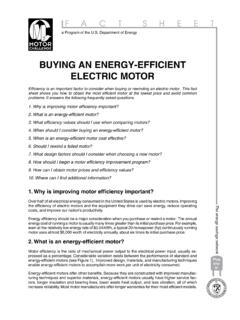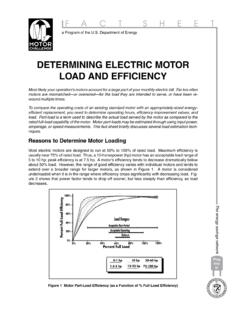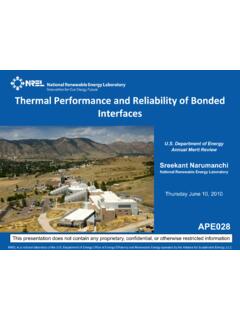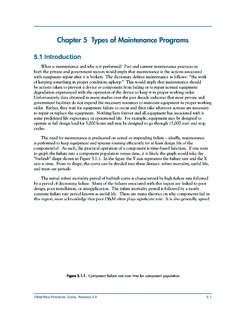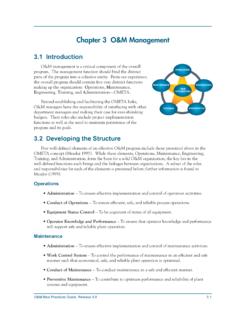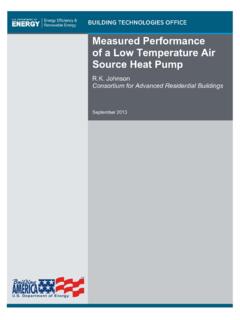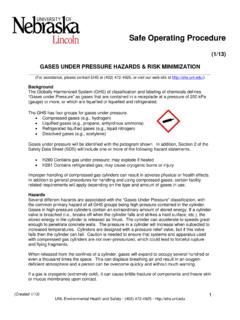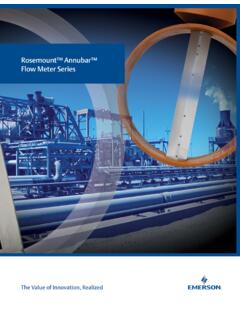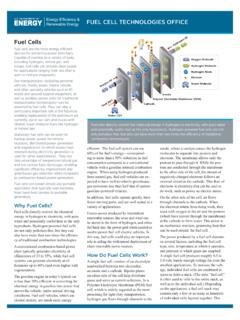Transcription of Hydrogen Fuel - Energy
1 Hydrogen Fuel Cell Engines module 1: Hydrogen PROPERTIES CONTENTS ATOMIC PHYSICAL ODOR, COLOR AND DENSITY AND RELATED CHEMICAL Hydrogen GAS KEY ENGINEERING PARAMETERS AND THEIR VOLUME AND MASS AND MASS Hydrogen Fuel Cell Engines and Related Technologies: Rev 0, December 2001 Hydrogen Fuel Cell Engines module 1: Hydrogen PROPERTIES OBJECTIVES At the completion of this module , the technician will understand: the atomic structure of Hydrogen the physical and chemical properties of Hydrogen how Hydrogen compares to hydrocarbon fuels in terms of Energy , flammability and safety the fundamental gas laws how pressure , temperature and mass flow are measured the units of pressure , temperature, volume, mass and mass flow as they relate to gases Hydrogen Fuel Cell Engines and Related Technologies: Rev 0, December 2001 Hydrogen Fuel Cell Engines module 1: Hydrogen PROPERTIES PAGE 1-1 Key Points & Notes Atomic Structure Hydrogen is by far the most plentiful element in the uni-verse, making up 75% of the mass of all visible matter in stars and galaxies.
2 Hydrogen is the simplest of all elements. You can visualize a Hydrogen atom as a dense central nucleus with a single orbiting electron, much like a single planet in orbit around the sun. Scientists prefer to describe the electron as occupy-ing a probability cloud that surrounds the nucleus some-what like a fuzzy, spherical shell. Figure 1-1 Atomic Structure of a Hydrogen Molecule In most Hydrogen atoms, the nucleus consists of a single proton, although a rare form (or isotope ) of Hydrogen con-tains both a proton and a neutron. This form of Hydrogen is called deuterium or heavy Hydrogen . Other isotopes of hy-drogen also exist, such as tritium with two neutrons and one proton, but these isotopes are unstable and decay radioac-tively. Most of the mass of a Hydrogen atom is concentrated in its nucleus. In fact, the proton is more than 1800 times more massive than the electron.
3 Neutrons have almost the same mass as protons. However, the radius of the electron s orbit, which defines the size of the atom, is approximately 100,000 times as large as the radius of the nucleus! Clearly, hydro-gen atoms consist largely of empty space. Atoms of all ele-ments consist largely of empty space, although all others are heavier and have more electrons. A proton has a positive electrical charge, and an electron has a negative electrical charge. Neutrons do not carry a charge. Hydrogen Fuel Cell Engines and Related Technologies: Rev 0, December 2001 Hydrogen Fuel Cell Engines module 1: Hydrogen PROPERTIES PAGE 1-2 Key Points & Notes Together, the charges associated with the proton and elec-tron of each Hydrogen atom cancel each other out, so that individual Hydrogen atoms are electrically neutral. Chemically, the atomic arrangement of a single electron orbiting a nucleus is highly reactive.
4 For this reason, hydro-gen atoms naturally combine into molecular pairs (H2 in-stead of H). To further complicate things, each proton in a Hydrogen pair has a field associated with it that can be visu-alized and described mathematically as a spin . Molecules in which both protons have the same spin are known as orthohydrogen . Molecules in which the protons have oppo-site spins are known as parahydrogen . Over 75% of normal Hydrogen at room temperature is ortho- Hydrogen . This difference becomes important at very low temperatures since orthohydrogen becomes unstable and changes to the more stable parahydrogen arrangement, releasing heat in the process. This heat can complicate low temperature Hydrogen processes, particularly liquefaction. Composition of Other Fuels It is natural for us to compare Hydrogen to other hydrocar-bon fuels with which we are more familiar.
5 All hydrocarbon fuels are molecular combinations of carbon and Hydrogen atoms. There are thousands of types of hydrocarbon com-pounds, each with a specific combination of carbon and Hydrogen atoms in a unique geometry. The simplest of all hydrocarbons is methane, which is the principal constituent of natural gas. (Other components of natural gas include ethane, propane, butane and pentane as well as impurities.) Methane has the chemical formula CH4, which means that each molecule has four Hydrogen atoms and one carbon atom. Other common hydrocarbons are ethane (C2H6), propane (C3H8) and butane (C4H10). These are all considered light hydrocarbons since they contain less than five carbon atoms per molecule and therefore have low molecular weight (a carbon atom is almost 12 times as heavy as a Hydrogen atom). Gasoline is composed of a mixture of many different hydro-carbons, but an important constituent is heptane (C7H16).
6 Gasoline, diesel, kerosene, and compounds found in asphalt, heavy oils and waxes, are considered heavy hydrocarbons as they contain many carbon atoms per molecule, and therefore have high molecular weight. Hydrogen Fuel Cell Engines and Related Technologies: Rev 0, December 2001 Hydrogen Fuel Cell Engines module 1: Hydrogen PROPERTIES PAGE 1-3 Key Points & Notes The lightest hydrocarbons are gases at normal atmospheric pressure and temperature. Heavier hydrocarbons, with 5 to 18 carbon atoms per compound, are liquid at ambient condi-tions and have increasing viscosity with molecular weight. Other chemical fuels include alcohols whose molecules com-bine an oxygen/ Hydrogen atom pair (OH) with one or more hydrocarbon groups. Common alcohol fuels are methanol (CH3OH) and ethanol (C2H5OH). These may be blended with hydrocarbons for use in internal combustion engines. Figure 1-2 Chemical Structure of Common Fuels Hydrogen Fuel Cell Engines and Related Technologies: Rev 0, December 2001 Hydrogen Fuel Cell Engines module 1: Hydrogen PROPERTIES PAGE 1-4 Key Points & Notes Physical Properties State All substances exist on earth as either a gas, liquid or solid.
7 Most substances will change from one of these states to another depending on the temperature and pressure of their surroundings. In general, a gas can be changed into a liquid by reducing its temperature, and a liquid to a solid by reduc-ing its temperature further. To some extent, an increase in pressure will cause a substance to liquefy and solidify at higher temperature than would otherwise be required. The transition from liquid to gas is known as boiling and the transition from liquid to solid as freezing. Accordingly, each substance has a characteristic boiling temperature and freezing temperature (at a given pressure ). The opposite transitions, from gas to liquid and solid to liquid, are known as condensation and melting respectively. The condensation temperature is the same as the boiling temperature and the melting temperature is the same as the freezing tempera-ture.
8 The process of condensation is also known as liquefac-tion and the process of freezing is also known as solidification. Boiling and freezing temperatures are most meaningfully compared relative to absolute zero . Absolute zero (0 R; 0 K; F; C) is the lowest temperature in the universe at which all molecular motion stops. Hydrogen has the second lowest boiling point and melting points of all substances, second only to helium. Hydrogen is a liquid below its boiling point of 20 K ( 423 F; 253 C) and a solid below its melting point of 14 K ( 434 F; 259 C) and atmospheric pressure . Obviously, these temperatures are extremely low. Tempera-tures below 100 F (200 K; 73 C) are collectively known as cryogenic temperatures, and liquids at these temperatures are known as cryogenic liquids. The boiling point of a fuel is a critical parameter since it defines the temperature to which it must be cooled in order to store and use it as a liquid.
9 Liquid fuels take up less stor-age space than gaseous fuels, and are generally easier to transport and handle. For this reason, fuels that are liquid at atmospheric conditions (such as gasoline, diesel, metha-nol and ethanol) are particularly convenient. Conversely, fuels that are gases at atmospheric conditions (such as hy-drogen and natural gas) are less convenient as they must be stored as a pressurized gas or as a cryogenic liquid. Hydrogen Fuel Cell Engines and Related Technologies: Rev 0, December 2001 Hydrogen Fuel Cell Engines module 1: Hydrogen PROPERTIES PAGE 1-5 Key Points & Notes The boiling point of a pure substance increases with applied pressure up to a point. Propane, with a boiling point of 44 F ( 42 C), can be stored as a liquid under moderate pres-sure, although it is a gas at atmospheric pressure . (At tem-peratures of 70 F (21 C) a minimum pressure of 111 psig ( barg) is required for liquefaction).
10 Unfortunately, hydro-gen s boiling point can only be increased to a maximum of -400 F ( 240 C) through the application of approximately 195 psig (13 barg), beyond which additional pressure has no beneficial effect. Hydrogen as a vehicle fuel can be stored either as a high- pressure gas or as a cryogenic liquid (Section ). Odor, Color and Taste Pure Hydrogen is odorless, colorless and tasteless. A stream of Hydrogen from a leak is almost invisible in daylight. Com-pounds such as mercaptans and thiophanes that are used to scent natural gas may not be added to Hydrogen for fuel cell use as they contain sulfur that would poison the fuel cells. Hydrogen that derives from reforming other fossil fuels (Sec-tion ) is typically accompanied by nitrogen, carbon dioxide, carbon monoxide and other trace gases. In general, all of these gases are also odorless, colorless and tasteless. Toxicity Hydrogen is non-toxic but can act as a simple asphyxiant by displacing the oxygen in the air.

